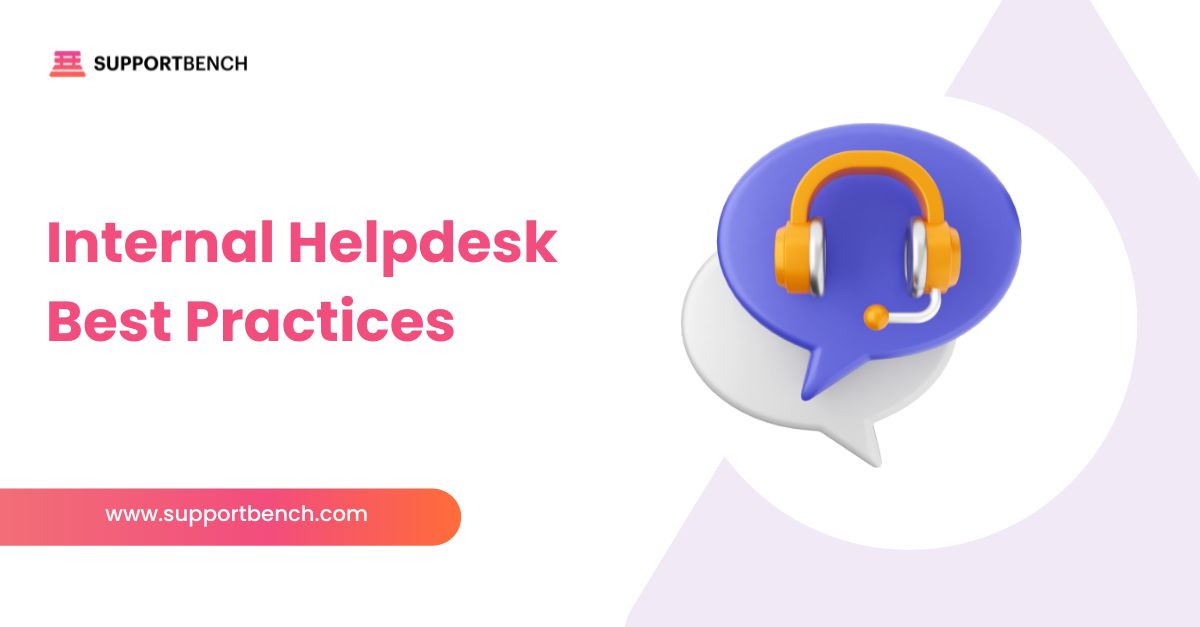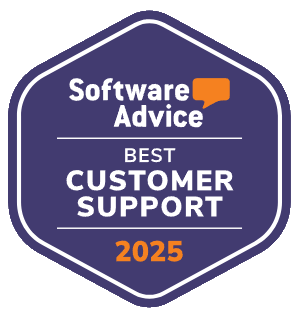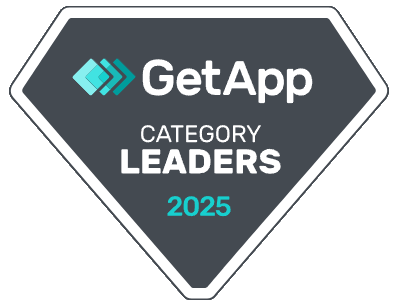An internal helpdesk plays a crucial role in keeping teams productive, operations smooth, and employees supported. It’s not just about fixing technical issues—it’s about enabling people to do their work without unnecessary delays or confusion.
When built with the right structure, a helpdesk becomes more than a support channel. It becomes a central part of your employee experience, helping reduce downtime, streamline communication, and build trust across departments.
But getting there takes more than good intentions or a basic ticketing tool. You need clear goals, simple workflows, strong internal communication, and the ability to evolve with your team.
This guide shares 12 best practices to help you build an internal helpdesk that works—not just for today, but as your business continues to grow. With tools like Supportbench, organizations can bring these practices to life through automation, real-time reporting, and scalable knowledge management.

Here is the Quick Answer:
A high-performing internal helpdesk improves employee satisfaction, speeds up support, and strengthens cross-team collaboration. Key best practices include setting realistic SLAs, using smart ticket routing, keeping a self-service knowledge base updated, and training agents regularly. Automating routine tasks, monitoring metrics like FCR and SLA adherence, and aligning with compliance standards helps maintain efficiency as your business grows. With platforms like Supportbench, teams can scale operations without sacrificing service quality.
1. Set Clear Ticket Categories and Routing Protocols
Confusion at the intake stage often leads to delays, miscommunication, or tickets landing in the wrong queue. A clear ticket structure helps staff submit accurate requests—and support teams resolve them faster.
Best Practices:
✔ Create Standard Categories: Define common request types like hardware issues, login/access problems, benefits or payroll questions, and compliance access. Use plain language so employees can self-select correctly.
✔ Use Auto-Routing Logic: Set rules to route tickets based on category, department, or keywords. For example, IT-related access issues go to the tech support team, while HR inquiries are routed to People Ops.
✔ Define Ownership and Escalation Paths: Clarify which team handles each category and what happens when a ticket is unresolved after a set time. Maintain an up-to-date routing chart to guide both agents and new hires.
Pro Tip: With Supportbench, you can automate routing using smart forms and tags—ensuring even first-time requesters get their tickets to the right team.
2. Set Realistic and Contextual SLAs
Service level agreements (SLAs) help teams measure performance and prioritize urgent issues—but only when they’re grounded in real-world capacity. Overpromising on resolution times can frustrate employees and overextend your agents.
Best Practices:
✔ Tailor SLAs by Request Type and Team: Set expectations based on complexity and urgency. For instance:
- Password resets: respond within 2 hours
- Equipment provisioning: resolve within 1 business day
- Compliance access: up to 48 hours for security reviews
✔ Audit SLA Breaches for Trends: Don’t just count missed SLAs—understand why they happen. Is it a staffing issue? A lack of clarity in ticket descriptions? Unclear ownership?
✔ Document SLA Commitments Internally: Communicate SLA targets across teams so that both requesters and agents understand timelines. Transparency helps manage expectations and reduce unnecessary follow-ups.
➤ Pro Tip: Supportbench’s SLA engine lets you set rules by department or ticket type, with automated alerts to keep tickets on track—without micromanagement.

3. Invest in a Self-Service Knowledge Base (and Keep It Updated)
An internal knowledge base is one of the most effective ways to reduce ticket volume. When employees can solve routine issues themselves—like resetting passwords or connecting to VPN—they don’t need to wait for IT.
But a knowledge base only works if it’s kept accurate, relevant, and easy to use.
Best Practices:
✔ Write for Non-Technical Users: Use plain language, avoid jargon, and structure articles with headings, step-by-step instructions, and screenshots. Make it as easy to follow as possible.
✔ Tag and Categorize: Organize content so it’s searchable by topic, department, or issue type. Use tags to connect related articles.
✔ Maintain It Like a Product: Review usage data monthly. Which articles are helping? Which ones are never viewed—or frequently lead to support follow-ups? Update or archive content based on real-world needs.
✔ Encourage Agent Feedback: Let helpdesk agents flag outdated or unclear articles during ticket resolution, so the content stays relevant and trustworthy.
➤ Compliance Tip: In industries like healthcare or finance, make sure internal documentation never includes sensitive data or personally identifiable information (PII).
➤ Did You Know? Supportbench includes built-in knowledge base tools with version tracking, article usage analytics, and auto-suggestion during ticket creation to reduce repeat inquiries.
4. Standardize Internal Communication Protocols
Strong internal communication isn’t optional—it’s foundational to an effective helpdesk. When agents don’t document updates clearly or departments operate in silos, ticket resolution slows down and users feel ignored.
Structured, transparent communication keeps everyone aligned and accountable.
Best Practices:
✔ Use Internal Notes Properly: Every ticket should include relevant context, actions taken, and next steps—recorded in a consistent internal notes format. Treat the notes as the single source of truth.
✔ Adopt Clear Status Labels: Avoid vague terms like “Working on it.” Instead, use specific statuses like “In Progress,” “Pending Info,” “Escalated to HRIS,” or “Awaiting Vendor.”
✔ Standardize Message Templates: Create reusable templates for common updates (e.g., password reset confirmation, hardware replacement in progress) to improve clarity and save time.
✔ Log Communication Touchpoints: Whether updates are delivered via email, chat, or portal, make sure every interaction is logged and time-stamped in the ticket thread.
➤ Tool Tip: Supportbench’s internal notes feature and status automation make it easy to keep communication visible, searchable, and consistent—no matter how complex the issue or how many teams are involved.

5. Train Agents Continuously, Not Just During Onboarding
Initial training sets the baseline—but continuous learning is what keeps your internal helpdesk resilient and responsive over time. As systems, policies, and tools evolve, so must your team’s skills.
Ongoing training helps agents stay sharp, confident, and aligned with business goals.
Best Practices:
✔ Monthly Tool Refreshers: Schedule recurring sessions to revisit changes in internal tools or platforms. This helps reinforce usage patterns and ensures new features aren’t overlooked.
✔ Briefings on Policy Updates: When IT, HR, or compliance policies change, hold short briefings to explain what’s new and how support procedures should adapt.
✔ Cross-Team Shadowing: Let agents shadow colleagues in other departments. This promotes empathy, reveals dependencies, and helps agents navigate escalations more smoothly—especially in hybrid or remote-first environments.
✔ Peer Reviews Using Real Tickets: Regularly review anonymized support tickets in team meetings. Use them as learning tools to discuss phrasing, diagnosis paths, and escalation triggers.
✔ Weekly Micro-Debriefs: Share quick wins, common stumbling blocks, or new documentation during weekly stand-ups. Small updates keep knowledge fresh and relevant.
➤ Pro Tip: Use Supportbench’s built-in dashboards to identify knowledge gaps—for instance, agents who close many tickets but generate high reopen rates may need coaching on root cause analysis.
6. Measure the Right Metrics and Act on Them
Performance data is only useful if it leads to insight. Too many internal helpdesks track surface-level metrics—like “tickets closed per day”—that don’t tell the full story. Real improvement comes from measuring what matters and making changes based on those findings.
Focus on metrics that reflect true impact:
- First Contact Resolution (FCR): Indicates how often agents fully resolve issues on the first interaction. High FCR reduces follow-ups and builds trust.
- Agent Reopen Rate: Tracks how frequently closed tickets are reopened. High rates suggest premature closures or insufficient resolutions.
- SLA Adherence: Go beyond averages—look at how consistently different teams and shifts meet SLAs across ticket types.
- Internal Satisfaction Score (ISAT): A brief, post-resolution rating gives you insight into employee sentiment: “Was your issue resolved? Rate 1–5.”
Best Practices:
✔ Review FCR and reopen rates monthly to pinpoint training gaps or workflow breakdowns.
✔ Break down SLA performance by department to surface where delays originate.
✔ Correlate ISAT scores with ticket categories to identify friction points.
✔ Use trend reports to inform staffing, escalation protocols, and knowledge base updates.
➤ Tip: Supportbench’s performance dashboards let you segment these KPIs by agent, department, or ticket type—making it easy to drill into what’s working and what needs change.
7. Build a Feedback Loop Between Agents and Requesters
Internal helpdesks don’t just support employees—they serve colleagues. If employees feel like their input is ignored or their frustrations are dismissed, confidence in the system quickly fades. Feedback isn’t a formality—it’s fuel for better service.
Best Practices:
✔ Request Feedback Regularly: Don’t wait until a quarterly survey. Use short post-ticket forms asking if the issue was resolved and if the experience was helpful.
✔ Enable Anonymous Submissions: Provide secure channels (via internal portals or HR tools) where employees can submit concerns or suggestions without fear of judgement.
✔ Summarize and Share Trends: Every month, publish an internal “What We’re Hearing” summary. Highlight recurring issues, common wins, and what’s being improved.
✔ Loop Agents In: Share feedback with support teams, not just managers. Knowing where they made an impact—or where someone felt let down—helps agents improve and stay connected to outcomes.
➤ Why It Matters: A responsive helpdesk isn’t just fast—it’s trusted. When employees see their feedback leads to visible improvements, they’re more likely to use the system consistently and constructively.
8. Use Automation Thoughtfully and Avoid Over-Automating
Automation can make internal support more efficient—but only when applied with purpose. Done poorly, it replaces human connection with canned responses. Done well, it streamlines common workflows, reduces manual errors, and keeps agents focused on meaningful tasks.
Best Practices:
✔ Automate the Right Things: Use automation for intake forms, ticket categorization, SLA timers, and low-level triage—not for complex human conversations.
✔ Preserve the Human Option: Always give employees a clear path to escalate to a real person. Automating too much can lead to frustration when needs are urgent or nuanced.
✔ Audit Automation Performance: Review auto-responses, closed-ticket triggers, and routing workflows every quarter. Check for false positives and “ticket loops” caused by bad logic.
✔ Educate Your Team: Make sure both agents and requesters understand how automation is used. Transparency avoids confusion and builds trust in the system.
➤ Tip for Regulated Industries: In healthcare, finance, or education, ensure automation complies with data governance policies. Role-based access and regular audits are non-negotiable.
➤ Why It Matters: The goal isn’t to replace agents—it’s to help them work smarter. Good automation makes internal support more predictable, faster, and scalable without compromising experience.
9. Align Helpdesk with Compliance and Security Standards
Internal helpdesks often handle sensitive requests—from access to HR records to employee health information. Without the right safeguards, support systems can become unintentional security risks or fall out of regulatory compliance.
Best Practices:
✔ Enforce Role-Based Access: Agents should only see tickets relevant to their department or permission level. A junior IT support agent, for example, shouldn’t have access to HR or legal tickets.
✔ Implement Secure Authentication: All agent logins should be protected by SSO (Single Sign-On) or MFA (Multi-Factor Authentication) to prevent unauthorized access.
✔ Enable Logging and Audit Trails: Track all actions on tickets involving sensitive data. This creates a paper trail for audits and helps identify misuse or policy violations early.
✔ Adhere to Retention Policies: Certain tickets (e.g., those containing health, payroll, or access data) may need to be archived, encrypted, or deleted after a set period to stay compliant with data privacy laws.
Common Compliance Frameworks to Consider:
Compliance Standard | Key Focus Area | Industries |
PIPEDA | Personal Information in Private Sector | Canadian Businesses |
| HIPAA | Health Information Privacy | Healthcare |
GDPR | Personal Data Protection | All (Especially in EU) |
| SOC 2 | System Controls & Data Security | SaaS, Tech, and Finance |
➤ Reminder: Your helpdesk is not just a service tool—it’s part of your compliance infrastructure. Neglecting this role risks exposure to audits, fines, and reputational damage.
➤ Why It Matters: When compliance is built into your helpdesk, it protects your organization, supports trust with employees, and reduces the risk of costly breaches or violations.

10. Continuously Review and Adjust
A successful internal helpdesk doesn’t stay static. Business needs evolve—new tools roll out, teams expand, and support volumes shift. To remain effective, your helpdesk must be flexible and regularly refined.
Build a Review Cadence That Works
✔ Monthly Performance Reviews: Track key metrics like SLA adherence, first contact resolution (FCR), and internal satisfaction (ISAT). Use this data to identify friction points or patterns in delays.
✔ Quarterly Feedback Loops: Send out short user surveys to capture the employee experience. Ask what’s working, what’s missing, and where confusion occurs. Supplement these with agent feedback sessions to gather process-level insights.
✔ Semi-Annual Process Alignment: Meet with department heads every six months to ensure your workflows, ticket categories, and SLAs still align with business goals. For example, if the finance team just launched a new expense app, support workflows may need updating.
✔ Track Shifts in Demand: Monitor changes in ticket volume by topic or source. A sudden spike in device access requests or remote login issues might indicate an unaddressed onboarding or system training gap.
Make Adjustment a Team Habit
✔ Hold a 30-minute monthly “retro” with support agents: Use it to review wins, call out recurring blockers, and brainstorm fixes. Keep it actionable.
✔ Introduce small experiments: For instance, test a new auto-response rule or update a knowledge base article and track its impact over two weeks.
✔ Document learnings: Keep a living changelog or internal wiki that tracks what’s been adjusted, why, and what results followed. This helps reinforce a learning culture and avoids backtracking on progress.
➤ Why It Matters: Reviewing isn’t about catching mistakes—it’s about designing a system that learns and improves over time. When you treat change as a constant, your helpdesk stays resilient and responsive.
11. Foster a Positive Team Culture
An internal helpdesk performs best when agents feel valued, supported, and invested in the work they do. High morale leads to higher-quality service, faster resolutions, and better collaboration—especially under pressure.
Focus on Recognition and Growth
✔ Celebrate Wins Publicly: Highlight top-performing agents during team meetings or weekly updates. Recognize not only volume but quality—like a difficult ticket resolved well or documentation improved.
✔ Encourage Peer Coaching: Create space for agents to share what’s working, offer feedback, and learn from one another. Rotate team members through weekly peer-review or “lunch & learn” sessions.
✔ Offer Cross-Training Opportunities: Let agents explore other areas like compliance support, onboarding workflows, or reporting. This builds bench strength and reduces single points of failure.
Make Culture a Daily Habit
✔ Hold Weekly Stand-Ups: A 15-minute touchpoint keeps the team aligned, allows early escalation of blockers, and gives space for shoutouts and updates.
✔ Promote Knowledge Sharing: Encourage agents to contribute to the knowledge base or flag gaps in workflows. Give credit when documentation is improved thanks to agent input.
✔ Check In Regularly: Conduct short one-on-one check-ins to understand workload, stress levels, and team morale. These aren’t performance reviews—they’re support conversations.
➤ Why It Matters: Support teams are often under pressure, fielding repetitive tasks, system glitches, and urgent employee issues. A positive, connected culture doesn’t just prevent burnout—it creates a helpdesk people trust and respect.

12. Plan for Scalability
What works for a team of 20 may buckle under the needs of a team of 200. An internal helpdesk must be designed not only for today’s support volume but also for tomorrow’s growth, organizational changes, and new technologies.
Key Practices to Build for Scale
✔ Introduce Structured Tiers (L1, L2, L3): Escalate based on complexity and agent expertise. This helps junior staff handle common issues, while specialists focus on more advanced or sensitive requests.
✔ Enable Skill-Based Routing: Route tickets to the most qualified person automatically using tags, forms, or agent specializations (e.g., HR policies, identity access, device support).
✔ Use Localization When Needed: For companies operating in multiple regions or time zones, route tickets based on location, language, or department to ensure relevance and compliance.
✔ Expand Dashboards as You Grow: Build dashboards by team, channel, or department so leaders can track support effectiveness across functions. This visibility helps prevent bottlenecks as new channels or roles are added.
✔ Document Processes Early: Keep workflows, SOPs, and escalation paths documented and centralized. This allows new hires to ramp up quickly and maintains consistency as teams expand.
Don’t Wait Until It Breaks
Scalability isn’t just a technical feature—it’s an operational mindset. Proactively designing for growth means your helpdesk can keep pace with headcount, complexity, and demand without service quality suffering.
➤ Tip: Platforms like Supportbench offer flexible licensing, role-based permissions, and advanced routing logic—all essential to scale without creating chaos.
Final Recommendation
An effective internal helpdesk is more than just a reactive support desk. It’s a structured, consistent, and scalable system that helps employees get answers quickly, reduces friction across departments, and ensures critical operations run smoothly.
By combining clear ticket routing, up-to-date knowledge bases, meaningful metrics, and automation that respects the human side of support, organizations can build a helpdesk that employees trust and rely on.
But structure alone isn’t enough. The right platform plays a critical role in bringing all these pieces together. That’s where Supportbench stands out.
With tools for automation, multichannel intake, customizable workflows, reporting dashboards, and secure access controls, Supportbench helps you implement internal helpdesk best practices—without the complexity.
➤ Bottom Line: A modern helpdesk should improve employee experience, reduce ticket volume, and scale with your business. Supportbench does just that.
Ready to build a better internal support experience? Book a free demo and explore how Supportbench helps your team work smarter, resolve issues faster, and stay in sync at every stage of growth.















